
World War I ends on November 11, 1918
World War I Ends: At 11 o'clock in the morning of the 11th day of the 11th month of 1918, the First World War - known at the time as the Great War - comes to an end.
By the end of autumn 1918, the alliance of the Central Powers was unraveling in its war effort against the better supplied and coordinated Allied powers. Facing exhausted resources on the battlefield, turmoil on the home front and the surrender of its weaker allies, Austria-Hungary, Bulgaria and the Ottoman Empire, Germany was finally forced to seek an armistice with the Allies in the early days of November 1918. On November 7, the German chancellor, Prince Max von Baden, sent delegates to Compiègne, France, to negotiate the agreement; it was signed at 5:10 a.m. on the morning of November 11.
Ferdinand Foch, commander in chief of all Allied forces on the Western Front, sent a message by telegraph to all his commanders: “Hostilities will cease on the entire front November 11 at 11 a.m. French time.” The commanders ordered the fighting to continue throughout the morning of November 11, prompting later accusations that some men died needlessly in the last few hours of the war. As the historian John Buchan has written of that memorable morning: “Officers had their watches in their hands, and the troops waited with the same grave composure with which they had fought.” As watch hands reached 11, “there came a second of expectant silence, and then a curious rippling sound, which observers far behind the front likened to the noise of a light wind. It was the sound of men cheering from the Vosges [mountains] to the sea.”
The Great War took the life of some 9 million soldiers; 21 million more were wounded. Civilian casualties caused indirectly by the war numbered close to 10 million. The two nations most affected were Germany and France, each of which sent some 80 percent of their male populations between the ages of 15 and 49 into battle. At the peace conference in Paris in 1919, Allied leaders would state their desire to build a post-war world that would safeguard itself against future conflicts of such devastating scale. The Versailles Treaty, signed on June 28, 1919, would not achieve this objective. Saddled with war guilt and heavy reparations and denied entrance into the League of Nations, Germany complained it had signed the armistice under false pretenses, having believed any peace would be a “peace without victory" as put forward by U.S. President Woodrow Wilson in his famous Fourteen Points speech of January 1918. As the years passed, hatred of the treaty and its authors settled into a smoldering resentment in Germany that would, two decades later, be counted - to an arguable extent - among the causes of the Second World War.
But that would all come later. On November 11, 1918, the dominant emotion for many on and off the battlefield was relief at the coming of peace, mixed with somber mourning for the many lives lost. In a letter written to his parents in the days following the armistice, one soldier - 26-year-old Lieutenant Lewis Plush of the American Expeditionary Force (AEF) - eloquently pondered the war's lasting impact: “There was a war, a great war, and now it is over. Men fought to kill, to maim, to destroy. Some return home, others remain behind forever on the fields of their greatest sacrifice. The rewards of the dead are the lasting honors of martyrs for humanity; the reward of the living is the peaceful conscience of one who plays the game of life and plays it square.”
History Channel / Wikipedia / Library of Congress / Detroit News
Wikipedia
World War I:
1918 - Germany signs an armistice agreement with the Allies in a railroad car in the forest of Compiègne, France. The fighting officially ends at 11:00 a.m., (the eleventh hour in the eleventh month on the eleventh day) and this is annually honoured with a two-minute silence. The war officially ends on the signing of the Treaty of Versailles on 28th June, 1919.
On this Date - Post World War I:
1918 - Józef Piłsudski assumes supreme military power in Poland - symbolic first day of Polish independence.
1918 - Emperor Charles I of Austria relinquishes power.
1919 - Veterans Day; coincides with other holidays Armistice Day and Remembrance Day, which are celebrated in other parts of the world and also mark the anniversary of the end of World War I.
1919 - Centralia Massacre (Washington); in Centralia, Washington deaths of four members of the American Legion and the lynching of a local leader of the Industrial Workers of the World.
1919 - Latvian War of Independence; Latvian forces defeat the Freikorps at Riga.
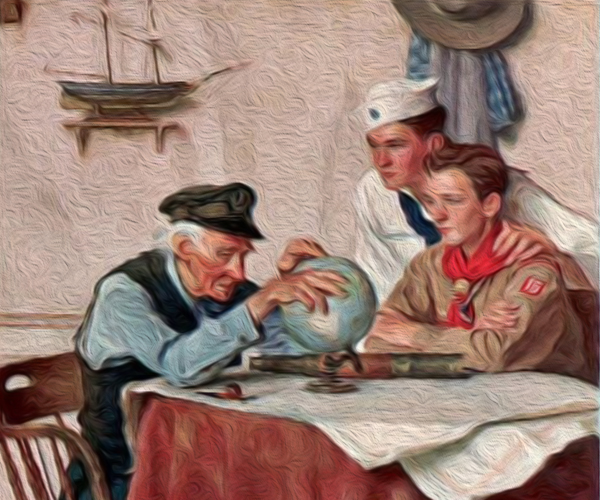
Understanding Military Terminology - fighter sweep
(DOD) Fighter sweep:
An offensive mission by fighter aircraft to seek out and destroy enemy aircraft or targets of opportunity in a designated area. Wikipedia / Air War College - Air University
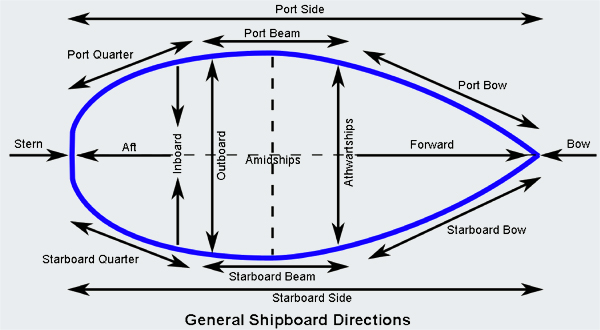
The Old Salt’s Corner
“List of ship directions”
abaft: onto or within a ship, or in a group.
aboard: at or toward the “stern” of a ship, or further back from a location.
above: a higher deck of the ship.
aft: toward the stern of a ship.
adrift: floating in the water without propulsion.
aground: resting on the shore or wedged against the sea floor.
ahull: with sails furled and helm lashed alee.
alee: on or toward the “lee” (the downwind side).
aloft: the stacks, masts, rigging, or other area above the highest solid structure.
amidships: near the middle part of a ship.
aport: toward the port side of a ship (opposite of “astarboard”).
ashore: on or towards the shore or land.
astarboard: toward the “starboard” side of a ship (opposite of “aport”).
astern: toward the rear of a ship (opposite of “forward”).
athwartships: toward the sides of a ship.
aweather: toward the weather or windward side of a ship.
aweigh: just clear of the sea floor, as with an anchor.
below: a lower deck of the ship.
belowdecks: inside or into a ship, or down to a lower deck.
bilge: the underwater part of a ship between the flat of the bottom and the vertical topsides
bottom: the lowest part of the ship's hull.
bow (or stem): front of a ship (opposite of “stern”).
centerline: an imaginary, central line drawn from the bow to the stern.
fore or forward: at or toward the front of a ship or further ahead of a location (opposite of “aft”).
inboard: attached inside the ship.
keel: the bottom structure of a ship's hull.
leeward: side or direction away from the wind (opposite of “windward”).
on deck: to an outside or muster deck (as “all hands on deck”).
on board: somewhere on board the ship.
outboard: attached outside the ship.
port: the left side of the ship, facing forward (opposite of “starboard”).
starboard: the right side of the ship, when facing forward (opposite of “port”).
stern: the rear of a ship (opposite of “bow”).
topside: on the ship's main weather deck.
underdeck: a lower deck of a ship.
yardarm: an end of a yard spar below a sail.
waterline: where the water surface meets the ship's hull.
weather: side or direction from which wind blows (same as “windward”).
windward: side or direction from which wind blows (opposite of l“leeward”)

“I’m Just Sayin’”
Since Americans throw rice at weddings, do Asians throw hamburgers?

“Thought for the Day”
“The true charter of liberty is independence, maintained by force.”
~ Voltaire

“What I Have Learned”
Share your knowledge. It’s a way to achieve immortality.
~ Anonymous

Bizarre News (we couldn’t make up stuff this good – real news story)

Repairing the “fashion” holes in earlobes is one of the fastest-growing cosmetic procedures in the UK, as “millennial generation” radicals tire of their half- to 3/4-inch, see-through lobes.
Doctors charge up to $3,000 to remove the entire area around the hole (originally created by stretching the tissue) and connect the healthy parts back so they fuse together. (A Hawaiian man, not currently a patient, supposedly has the largest ear hole, nearly four inches in diameter.) The Guardian

Mr. Answer Man Please Tell Us: Is multiple sclerosis increasing?
It seems almost everyone I've spoken with in the past few years has a family member or friend with a diagnosis of multiple sclerosis. What's going on here? Is the incidence increasing? Is it being recognized with greater accuracy due to improved testing? Or is it one of those catch-all diagnoses for unexplained problems of the central nervous system?
Multiple sclerosis seems to be increasing, possibly a lot. A rare disease once upon a time, MS is now the most common neurological disorder affecting young adults of northern European descent. In the U.S. alone, an estimated 266,000 to 400,000 people currently have it.
MS is a chronic, incurable condition that can’t be prevented or effectively treated. The body’s own white blood cells strip the protective sheathing (myelin) off nerve cells in the brain and spinal cord, leading to poor nerve function and a wide range of debilitating symptoms — numbness or tingling, dizziness, weakness, spasms, loss of coordination, problems with vision and urination. MS won’t kill you directly, but it can take five to ten years off your life.
The causes of MS remain mysterious, although some trends are evident among those who get it. There’s a definite genetic tendency towards the disease, although twin studies show environmental factors also play a part. Cigarette smoking is implicated not only for prevalence but severity of symptoms.
It’s long been thought there was a link between latitude and MS — people living above 42 degrees north (Chicago, Rome) were more likely to get the disease, and the further north you went, the greater the risk. A 2011 study in Sweden concluded the prevalence of MS increased by 1.5 percent for men and 1 percent for women for each degree of latitude further north. The same effect has been found in Japan and an equivalent southern-hemisphere effect in New Zealand, where the risk increases as you head south.
Other researchers downplay the latitude gradient, saying the real problem is vitamin D deficiency. Latitude figures in this because the greater your distance from the equator, the lower your exposure to ultraviolet radiation, specifically the shorter-wavelength UV-B, and the less vitamin D you produce. Some claim to see a link between spring/early-summer birthdays and MS, which could be tied to mothers’ lower UV-B exposure during pregnancy.
Research in the U.S. indicates an east-west gradient for MS prevalence, possibly related to the spread of Scandinavian immigrants across the country. Meanwhile back in Norway there seems to be reduced risk in the northernmost regions, possibly due to greater local consumption of oily fish. To further confuse matters, there’s apparently little relationship between MS and vitamin D in food, although vitamin D supplements may have a protective effect.
MS is mostly a problem for those of northern European ancestry — it’s rare in Asia, Africa, and the Middle East. That’s not just because nonwhites tend to live closer to the equator. In Australia and New Zealand, for example, MS is far more common among those of British background than Aborigines and Maori.
Back to the fundamental question: Is MS becoming more common? Sure looks that way. A 35-year Australian study found the MS prevalence (total-cases) rate tripled and the incidence (new-cases) rate doubled between the early 1960s and the mid-1990s. A study of one county in Norway found incidence went up by a factor of 3.3 over 50 years, with smaller increases in other counties.
Women have borne the brunt of the jump in MS. Between 1950 and 2000 the ratio of women to men with the disease increased by about 1.4 percent per year. Nowadays it’s estimated that women are 50 to 300 percent more likely to be diagnosed with MS than men.
Why? Nobody knows. One possibility is women are simply more likely to seek help for MS-like symptoms. Other hypotheses include more obesity, increased use of oral contraceptives and hormone-replacement therapy, and a trend towards later childbirth. Then again, research shows MS was increasing in women even in the pre-Pill days, and for that matter before any of these other trends had emerged.
Improved diagnosis undoubtedly does explain some of the increase. One study found MS rates in parts of Finland were fairly stable from 1979 to 1993, then more than doubled between 1994 and 1998 — a jump the investigators attributed to greater use of magnetic resonance imaging to aid in diagnosis. (While there’s no definitive MS test and diagnosis is partly a process of elimination, using MRI to look for lesions in the nervous system eliminates some of the guesswork.)
Another explanation for the increase is that people with MS are living longer. Still, factoring all that out, the consensus seems to be that there’s been a real increase in MS in the past 50 years, possibly due to some unknown environmental cause.
I don’t mean to be alarmist. A disease that even in hotspots afflicts three people in a thousand doesn’t qualify as the next Ebola. The fact remains that if you’re a woman of northern European extraction and someone in your family has MS, there’s a growing chance you’ll get it too.
Research: National Multiple Sclerosis Society.org
• Mayo Clinic.org
• Overcoming Multiple Sclerosis.org
• NCBI.nlm.nih.gov
• MSAA
• NABC News
• Wikipedia

Where Did That Saying Come From?
“By hook or by crook:”
This old saying probably comes from a Medieval law which stated that peasants could use branches of trees for fire wood if they could reach them with their shepherds crook or their billhook.Phrases.org.UK
Image: @copy; Captain Hook - Peter Pan Disney

NAVSPEAK aka U.S. Navy Slang
Crunch: Aircraft handling mishap that results in structural damage to one or more aircraft.
Form: Short for formation. This is when two or more aircraft or ships maneuver in close proximity while maintaining constant relative positions to each other.
Kiss the Camel: To fall between ship and pier onto the camel, a floating log chained to the pilings as a fender. Such a mishap is frequently fatal.
Raisin: Recruit or junior sailor, predominantly heard at Naval Training Commands. Usually used by seasoned A-School students to refer to sailors with one or more weeks less time in service. Fleet equivalent is “Nub”, “Newbie”, or “Hey Shitbird”.

Just for you MARINE
Colors: The time of day when the national flag is hoisted or lowered from the flagpole. All personnel stop and render appropriate honors during this period. Also the flag of a specific unit upon which the battle streamers are mounted.
Combat Action Ribbon: The Naval Services equivalent of the Army's Combat Infantryman Badge. Those sailors and Marines who wear this ribbon have seen actual combat (been shot at and shot back). It is a significant badge of honor.
Combat Correspondents: Marines who report war news from the front and who assist the news media in reporting about Marines in combat. They are trained at the Defense Information School. See United States Marine Corps Combat Correspondents Association.
COMCIVLANT Navy version of 1st Civ. Div. COMmander, CIVilians, AtLANTic.

Navy Acronyms
EAOS - End of Active Obligated Service
Date at which one’s Naval service has been officially completed.
ENL - Enlisted
Rank achieved by Sailors who have completed the minimum educational requirement of a high school diploma.
EOD - Explosive Ordnance Disposal
Technicians tasked to safely dispose of explosive materials.
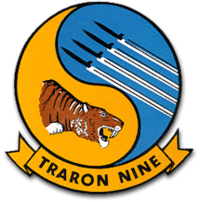
Naval Aviation Squadron Nicknames
VT-9 - Training Squadron 9: “Tigers” NAS Meridian, Mississippi

The Strange, Mysterious or Downright Weird
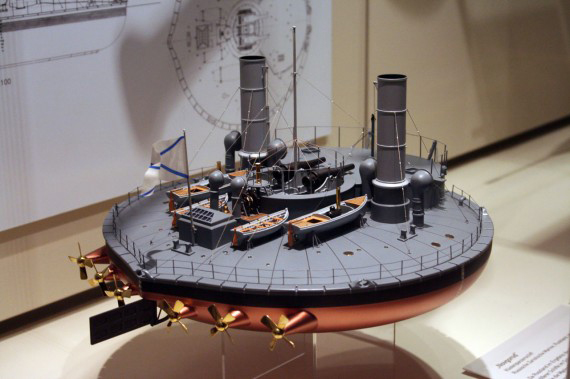
Boats share the same basic design for a reason. Unfortunately, nobody bothered telling that to the Imperial Russian shipwrights who in 1874 unveiled a proudly distinct vessel they called Novgorod. In theory, the ship’s circular design—just over 100 feet in diameter—provided a stable platform for large guns, making it the perfect defender for the Russian coast.
In practice, the Novgorod was a disaster, a fact that became abundantly clear as it floated into the Danube to take part in the Russo-Turkish War of 1877–1878. Since the ship’s hull wasn’t streamlined, faster boats had to tow the floating bucket into battle. Russia was in no hurry to get the Novgorod in the mix, though. The circular design had clear limitations in combat: The odd shape meant that each time its cannons fired, recoil spun the vessel like a top. In short, it was a slow, cumbersome ship that couldn’t really fire its guns. After enduring much snickering from the Turks, the Russians decided to keep the Novgorod tied up at port, finally relegating it to the scrapyard in 1912.
Mental Floss / Wikipedia / Land by Sea

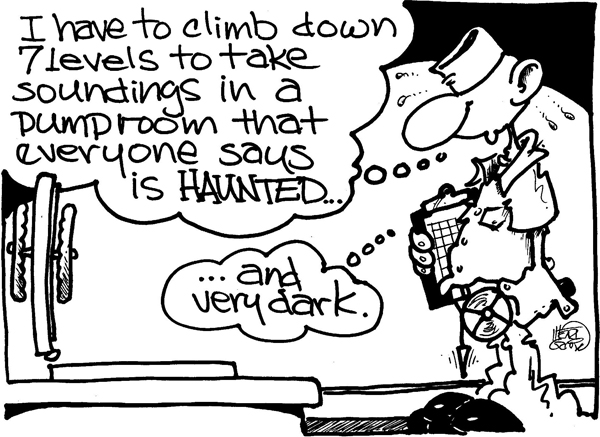
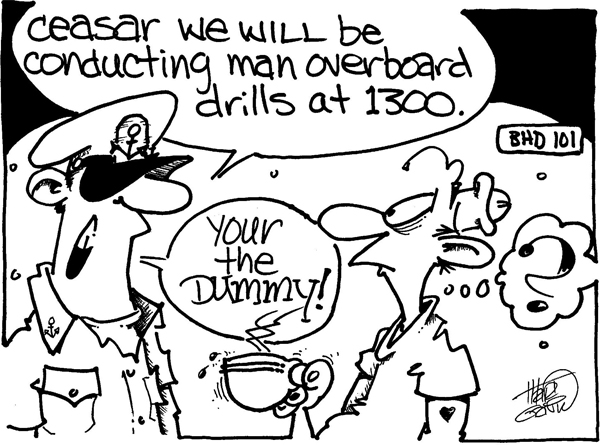

SONG FACTS
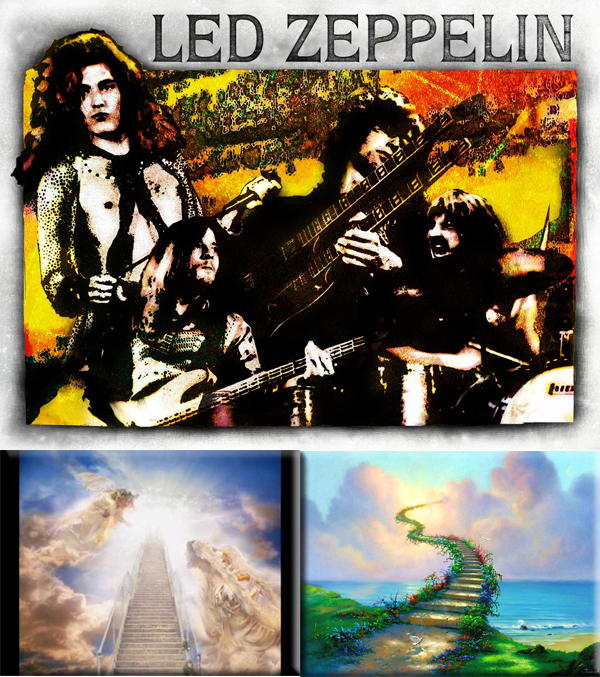
“Stairway To Heaven” - Led Zeppelin
Released 1971 
The most famous rock song of all time, this didn't chart because it was never released as a single to the general public. Radio stations received promotional singles which quickly became collector's items.
Robert Plant spent much of the '70s answering questions about the lyrics he wrote for “Stairway”. When asked why the song was so popular, he said it could be its “abstraction”, adding, “Depending on what day it is, I still interpret the song a different way - and I wrote the lyrics.”
The lyrics take some pretty wild turns, but the beginning of the song is about a woman who accumulates money, only to find out the hard way her life had no meaning and will not get her into heaven. This is the only part Plant would really explain, as he said it was “a woman getting everything she wanted without giving anything back”.
Led Zeppelin started planning “Stairway” in early 1970, when they decided to create a new, epic song to replace "Dazed And Confused" as the centerpiece of their concerts. Jimmy Page would work on the song in an 8-track studio he had installed in his boathouse, trying out different sections on guitar.
The lyrics came to Robert Plant in a flash of inspiration when he and Jimmy Page were sitting by the fireplace at Headley Grange with Page strumming the intro chords. Said Plant: “I was holding a pencil and paper, and for some reason I was in a very bad mood. Then all of a sudden my hand was writing out the words, “There's a lady who's sure all that glitters is gold/And she's buying a stairway to heaven.” I just sat there and looked at the words and then I almost leapt out of my seat.“
The song is rumored to contain backward satanic messages, as if Led Zeppelin sold their souls to the devil in exchange for “Stairway To Heaven”. Supporting this theory is the fact that Jimmy Page bought Aleister Crowley's house in Scotland, known as Boleskine House. In his books, Crowley advocated that his followers learn to read and speak backwards.
Robert Plant addressed the issue in an interview with Musician magazine: “Stairway To Heaven” was written with every best intention, and as far as reversing tapes and putting messages on the end, that's not my idea of making music. It's really sad. The first time I heard it was early in the morning when I was living at home, and I heard it on a news program. I was absolutely drained all day. I walked around, and I couldn't actually believe, I couldn't take people seriously who could come up with sketches like that. There are a lot of people who are making money there, and if that's the way they need to do it, then do it without my lyrics. I cherish them far too much.”
The song runs 8:03, but still became one of the most-played songs on American radio, proving that people wouldn't tune out just because a song was long. It was a perfect fit for FM radio, which was a newer format challenging the established AM with better sound quality and more variety. “Stairway” fit nicely into what was called the “Album Oriented Rock” (AOR) format, and later became a staple of Classic Rock. By most measures, it is the most-played song in the history of FM broadcasting in the United States. It has also sold more sheet music than any other rock song - about 10,000 to 15,000 copies a year, and more than one million total.
Jimmy Page has a strong affinity for this song, and felt Robert Plant's lyrics were his best yet. He had him write all of Zeppelin's lyrics from then on. In an interview with Rolling Stone magazine (March 13, 1975) the interviewer, Cameron Crowe, asked Jimmy Page how important “Stairway To Heaven” was to him: Page replied: “To me, I thought ‘Stairway’ crystallized the essence of the band. It had everything there and showed the band at its best... as a band, as a unit. Not talking about solos or anything, it had everything there. We were careful never to release it as a single. It was a milestone for us. Every musician wants to do something of lasting quality, something which will hold up for a long time and I guess we did it with ‘Stairway’.”
This was the only song whose lyrics were printed on the album's inner sleeve.
Rolling Stone magazine (March 13, 1975 - The Durable Led Zeppelin) / Wikipedia / Jimmypage.co.UK
Image: Led Zeppelin (“Stairway to Heaven” was voted #3 in 2000 by VH1 on its list of the 100 Greatest Rock Songs, and was placed at number 31 on Rolling Stone magazine's list of ”The 500 Greatest Songs of All Time“.)

Trivia
● Though his wife Martha had four children by a previous marriage, George Washington left no direct descendant. He never sired a child to continue his family line.
● President William H. Taft was once offered a contract to pitch for the Cincinnati Reds.
● Two towns in Vermont claim to be President Chester A. Arthur's birthplace, but recent research supports his opponents' charges that he was born in Canada, and therefore, was not eligible to be president under the U.S. Constitution.
A Test for People Who Know Everything
What is the most recorded song of all time – with more than 2000 versions?
● All Along the Watchtower / Answer for People Who Do Not Know Everything, or Want to Verify Their AnswerWikipedia
Answer to Last Week's Test
In trucking circles, what do truckers call a tailgater who is following another vehicle too closely?
Answer: “bumper sticker”
Joke of the Day
There was a preacher who was an avid golfer. Every chance that he could get, he could be found on the golf course swinging away.
On one particular Sunday it turned out to be a picture perfect day for golfing. The sun was shining, the temperature was just right and there was very little wind. The preacher was in a quandary and wasn't sure what to do....play golf or give the Sunday service. The urge to play golf overcame him and he called in his assistant to take care of the Sunday service for him. The preacher packed up his car and drove 3 hours to a course where no one would recognize him.
An angel above was watching the preacher and was quite perturbed. The angel went to God and said, “look at the preacher. He should punished for what he is doing.” God nodded in agreement.
All alone but enjoying it immensely, the preacher teed up on the first hole. He swung at the ball and hit a perfect drive. The ball ripped through the still air straight as an arrow and 400 yards later it landed the green where it gently rolled into the cup. A tremendous hole in one!
The preacher was amazed and excited. The angel was in shock. The angel turned to God and said, “Begging your pardon, but I thought that you were going to punish him?”
God smiled and said, “I did....think about it....who can he tell about this?”























